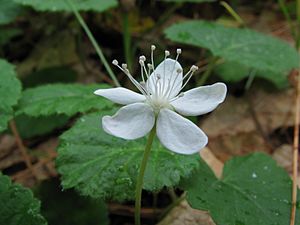Dalibarda facts for kids
Quick facts for kids Dalibarda |
|
|---|---|
 |
|
| Foliage and flower | |
| Scientific classification | |
| Kingdom: | |
| (unranked): | |
| (unranked): | |
| (unranked): | |
| Order: | |
| Family: | |
| Genus: |
Dalibarda
|
| Species: |
D. repens
|
| Binomial name | |
| Dalibarda repens L. 1753
|
|
| Synonyms | |
Dalibarda repens is a small plant known by many fun names. Some people call it the dewdrop, false violet, star violet, or Robin runaway. In French Canada, it's known as dalibarde rampante. This plant is a type of perennial that grows back every year. It belongs to the rose family, just like roses and strawberries!
You can find this plant growing naturally in eastern and central Canada. It also grows in the northeastern and north-central parts of the United States. Dalibarda repens is the only species in its group, called the Dalibarda genus. It's very similar to the Rubus genus, which includes plants like blackberries and raspberries. Sometimes, scientists even include it in the Rubus group. This plant is quite easy to grow in shady spots. It likes damp or wet, acidic soils. People often plant it in wildflower gardens or bog gardens as a ground-cover. This means it spreads out and covers the ground.
Contents
What Does the Dewdrop Plant Look Like?
The dewdrop plant is a herbaceous plant. This means it has soft stems, not woody ones like a tree. It has simple leaves and stems that feel a bit hairy. It's the only plant of its kind in the Dalibarda group.
Flowers of the Dewdrop
The dewdrop plant has two kinds of flowers. Some flowers are called sterile flowers. These are not as common. They have five white petals and grow on top of a stalk. The other kind of flowers are called fertile flowers. There are many more of these. These special flowers are cleistogamous. This means they pollinate themselves and never actually open up! They stay hidden under the leaves. The stalks of these hidden flowers are short, about 2 to 5 centimeters long. They also curve downwards.
Stems and Leaves
The stem of the dewdrop plant creeps along the ground. It can be several inches long. The end of the stem has a thick bunch of leaves and flowers. The leaves grow from the base of the plant. They are simple leaves with long stems called petioles. Both sides of the leaves are a little bit hairy. They are a dark green color. The leaf blades are shaped like a heart or are round. They are about 3 to 5 centimeters long. The edges of the leaves are scalloped, meaning they have low, rounded teeth. The leaf stems are hairy and can be 3 to 10 centimeters long.
Why is it Called "False Violet"?
The common name "false violet" comes from two things. First, the leaves are shaped like hearts, just like violet leaves. Second, this plant, like violets, produces two different kinds of flowers.
Where Does the Dewdrop Plant Grow?
The dewdrop plant is generally safe and not in danger around the world. However, it is rare in some specific places. For example, it is considered endangered in Connecticut, New Jersey, North Carolina, and Rhode Island. It is also listed as threatened in Michigan and Ohio.
How to Spot a Dewdrop Plant
You can identify this plant because it grows low to the ground. It spreads using runners, which are like little arms that grow out. Leaves and flowers grow on separate stalks from these runners. The white flowers that open have 5 wide petals. They also have many long stamens, which are the parts that hold pollen. These flowers grow alone on a long, reddish stalk. The leaves are shaped like a kidney and have a long stem. Their outer edges are scalloped. The whole plant usually grows to be about 2 to 5 inches tall.
Dewdrop vs. Violet Leaves
It's easy to mix up dewdrop leaves with violet leaves. But there's a trick to tell them apart! Violet leaves have low, rounded teeth that curve upwards. Dewdrop leaves, however, have low scalloped edges or blunt teeth that point outwards.
Where You Can Find It
This plant grows from Minnesota in the west all the way to Nova Scotia in the east. It also grows south to Michigan, Pennsylvania, and New Jersey. You can also find it in the mountains of North Carolina. Dewdrop plants like northern or upland forests. They prefer shady spots. You'll often find them in moist or wet forests with conifer trees (like pines) and mixed forests (with both softwoods and hardwoods). They also grow in swamps. They especially like sandy, acidic soils, which means the soil has a low pH.
Fun Facts About Dewdrop
The dewdrop plant produces a few small, white fruits. These fruits are called drupes. They are about 3 to 4 millimeters long and stay inside the flower's outer leaves.
Just like its relatives in the Rubus family (like raspberries), the young dewdrop plants can be cooked. They can be used as a "pot-herb," which means they can be cooked like a vegetable. You can also make a mild tea from them throughout the growing season. The fruit can be eaten, but it doesn't taste very good.
The dewdrop plant usually flowers from June to August.
See also
 In Spanish: Rubus para niños
In Spanish: Rubus para niños

